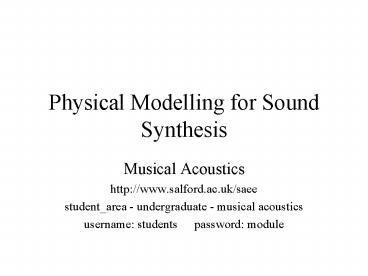Physical Modelling for Sound Synthesis PowerPoint PPT Presentation
1 / 20
Title: Physical Modelling for Sound Synthesis
1
Physical Modelling for Sound Synthesis
- Musical Acoustics
- http//www.salford.ac.uk/saee
- student_area - undergraduate - musical acoustics
- username students password module
2
Sound Synthesis
- Synthesise timbres of real instruments or create
new timbres - We have seen
- Oscillation as modes of vibration
- Timbre defined by relative amplitudes (and
frequencies) of modes with respect to time - Approaches
- Emulate the sound
- Model how musical instruments generate sound
- Excitation (free, forced, - displacement,
velocity, driver?) - Wave-guide (harmonics, skewed , non-linear?)
- Resonator (radiation, damping, formants - second
order resonant behaviour and effects on
wave-guide?)
3
Additive Synthesis
B3 Hammond Organ
Build relative amplitudes of harmonics with
drawbars
Vibrato and Chorus from rotating horn of Leslie
Speaker (Doppler Effect)
Some temporal control of 2nd or 3rd harmonic
4
Subtractive Synthesis
Harmonically rich wave forms (sawtooths and
square waves) filtered to shape timbre
Minimoog
Vibrato and modulation from Low Frequency
Oscillator Detuned oscillator gives
chorus/phasing effect
Some temporal control with ADSR envelopes for
amplitude and filtering
5
Wave equations beyond the 1D case
n1,2,3,4,5 m1,2,3,4,5.
Bars, Plates, Membranes, Bells,
Cymbals Increase in eigen values inharmonic
overtones
6
FM Synthesis
Yamaha DX7
6 Oscillators Operators routed to modulate each
other via Algorithms
ADSR envelope
Phase constants
..carrier frequency
..modulating frequency
modulation index envelope varies the amount of
higher overtones
7
FFT of FM bar - MATLAB
8
Sampling
Fairlight
Digitises sound of musical note Increases/Decreas
e Pitch by speeding up or slowing down
playback Increase volume with key strike pressure
The munch-kin effect
9
Sampling Solutions
Multiple samples across pitch range Multiple
samples across velocity ranges Interpolation
between samples Duration and Formant preservation
Nemesys Giga Sampler
Rolands VP9000 VariPhrase Sampler
10
Modular and Virtual Modular Synthesis
A modular paradigm allows for additive,
subtractive, fm and sampling synthesis techniques
to be used together
SynC modular
11
Physical Modelling
- Modelling sound generation
- more expressive and realistic sounds
- ideal for software implementation
- no need for dedicated hardware
- Brut force approach
- solve equations of motion with respect to
boundary conditions - Better Approach
- Partway solve equations for changing parameters
- lookup tables
- lumped processes
- novel algorithms
Yamaha VL1
12
Digital Wave-guide Modelling
Da-lemberts Solution .. Waves travel in equal an
opposite directions
Reflected and attenuated at boundary
Boundary behaviour frequency dependant
13
Digital Wave Guide Modelling
Energy in (pluck, hammer, bow, etc) Delay line
simulates time wave travels Feed back loop
simulates reflection Filter simulates frequency
dependant attenuation
14
Modelling an electric guitar
Array represents wave-guides Add displacement at
specific point Data passes between elements Low
Pass Filter for bridge Tap data at pickup
point Can hence delay, modify and add back as
feedback
15
What about real guitars?
Complex frequency dependence of bridge impedance
(could use recorded impulse response of resonator)
Coupling between horizontal and vertical planes
of string vibration causing beats (could use two
out of tune waves guides)
16
Excitation of Physical Model
- Pluck adds displacement
- Hammeradds velocity
- Bowing has slip stick mechanism
- Blowing modulated air stream .. interacts with
wave-guide
17
Modelling Wind Instruments
Need to consider two way interaction between wave
guide and excitation source
18
Including Continuous Excitation
Empirical formulae for interaction e.g. reed
with wave-guide Can use look up tables for non
linear behaviour
19
Perry Cooks Flute
- Two feedback loops
- conventional delay line and filter
- interaction of breath with energy bouncing back
from bell
Polynomial represents increasing interaction
with excitation source up to a threshold
20
The Future
Physical modelling of more complex
systems Multiple digital wave-guides and
linkages Physical modelling of imaginary
instruments Physical modelling of traditional
synthesisers (ironic)

